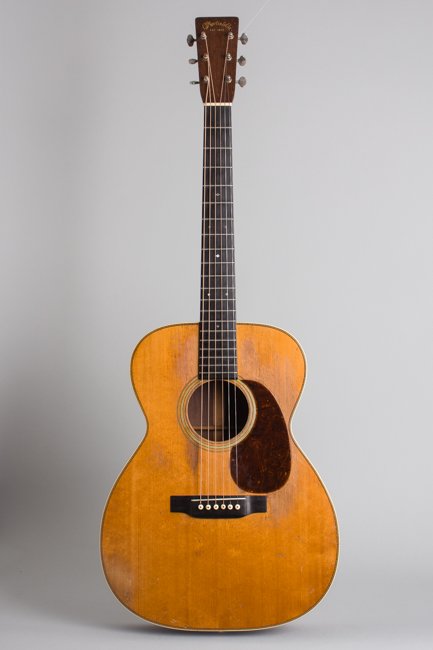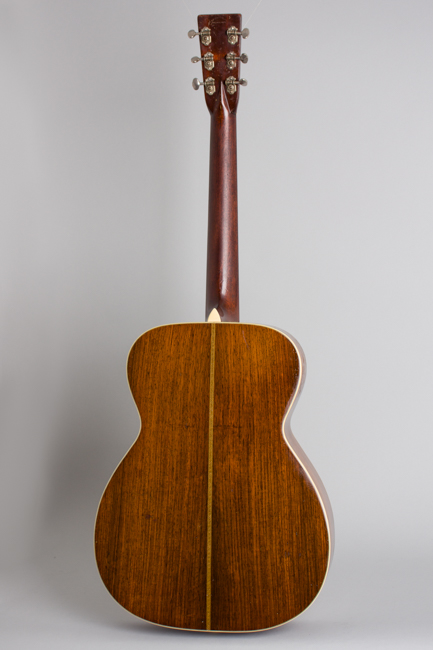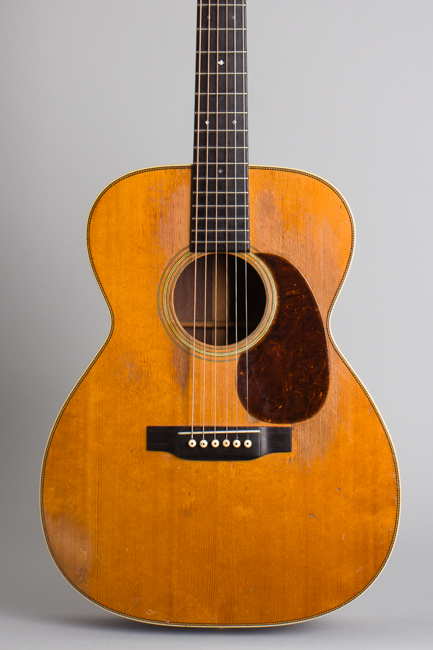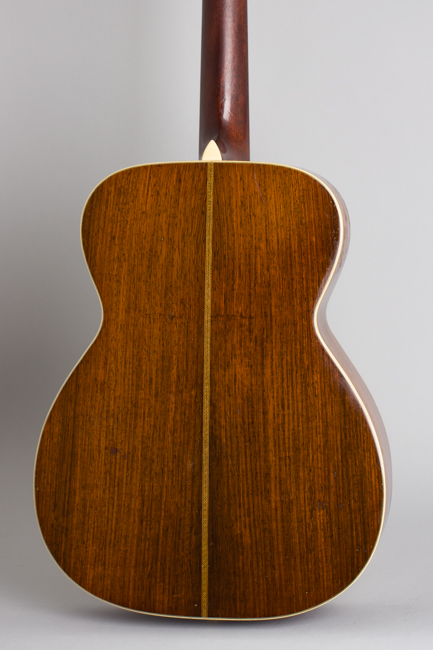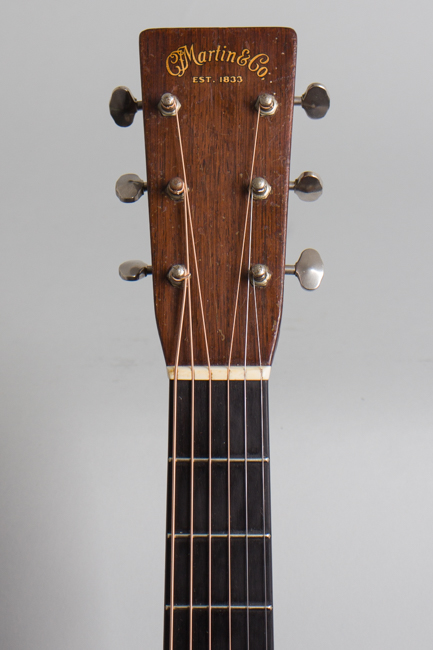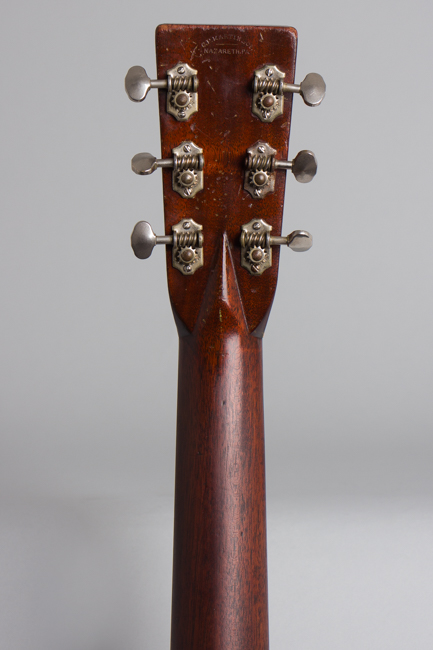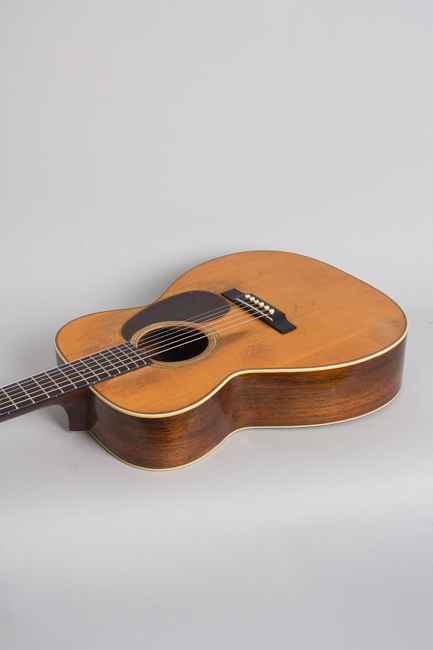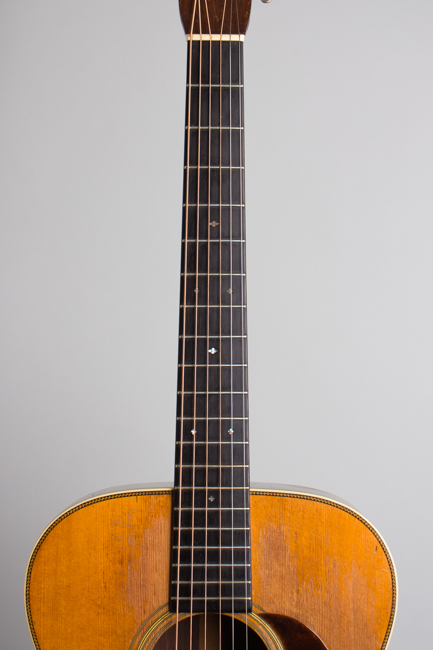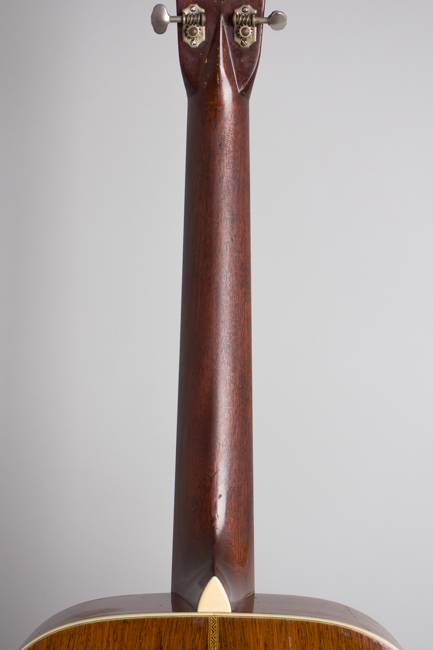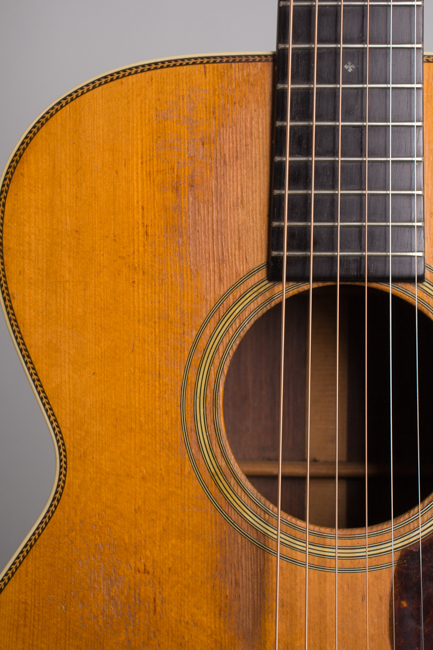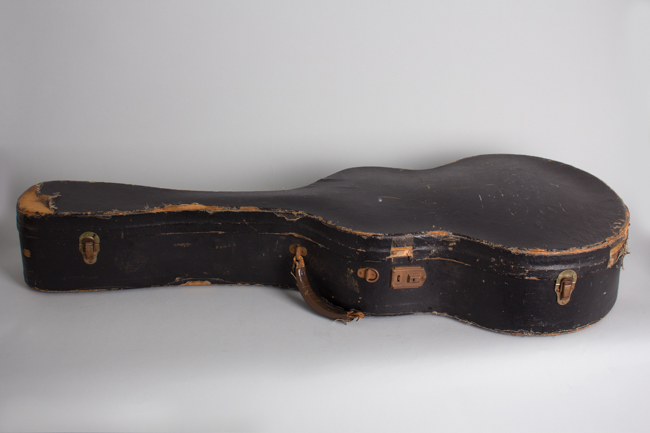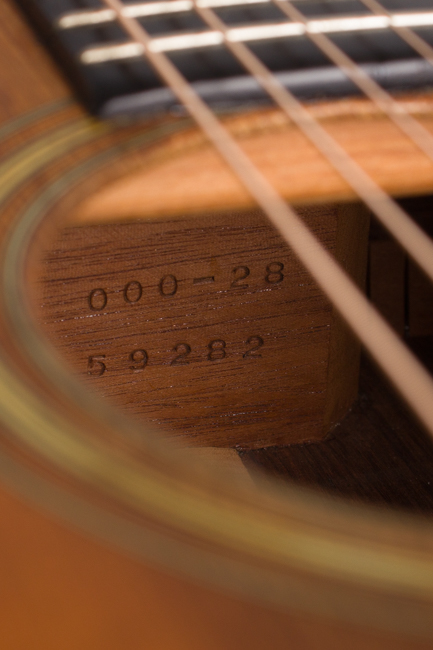C. F. Martin 000-28 Flat Top Acoustic Guitar (1935)
This item is currently on hold.
Item # 12064
Prices subject to change without notice.
C. F. Martin 000-28 Model Flat Top Acoustic Guitar (1935), made in Nazareth, PA, serial # 59282, natural lacquer finish, Brazilian rosewood back and sides, Appalachian spruce top; mahogany neck with ebony fingberboard, original black tolex hard shell case.
This is a lovely original Martin "Herringbone" 000-28 from 1935, a well worn but still exceptional guitar by any standard. It offers the full package of pre-war Martin goodness with the earlier "forward shifted" scalloped X Bracing that has become the connoisseur's choice feature. There are certain guitars that are simply the standard by which others are judged and a pre-war 14 fret 000-28 is certainly one of them. This instrument has seen some noticeable wear and typical maintenance repair but structurally remains a fine guitar even almost 90 years along.
The 1935 000-28 is to some players about the perfect flat-top guitar. The 15 1/4" wide narrow waisted body is just over 1/2" smaller than the Dreadnought but yields a powerful but generally more focused midrange sound. The lightly scallop-braced top makes the instrument extremely responsive, offering considerable power and depth combined with sweetness, sparkle, and a singing character. The scale length is slightly shorter than the early 1930s OM model which makes the action a bit more supple.
This 000 shows all the classic pre-war appointments, widely imitated ever since. The back and sides are Brazilian rosewood with a very straight and even figure. The top is Appalachian red spruce; this one has an interesting grain pattern with a lighter streak on each lower bout and a darker shading on the outside area. It is bordered with the famous "herringbone" wood trim that has come to define the "28" models, bound on the outside with ivory celluloid. The back is triple-bound in celluloid with a zip-zag pattern backstrip. Other features include the 1930s long-saddle ebony bridge, multiple celluloid sound hole rings and a dark brown tortoise celluloid pickguard.
The neck is mahogany with an unbound ebony fingerboard decorated with discreet slotted diamond pearl inlay. The peghead is faced in straight grained Brazilian rosewood with the gold "C.F. Martin & Co." decal at the top. The neck profile is round backed but with the slightest hint of a "V" profile in the way the sides bear away from the center as it moves towards the body; the nut is the 1 3/4" width of the mid-'30s. When this guitar was made the metal T-bar reinforcement was a newly-adopted feature. The tuners are the early Grover G-98 Sta-Tites with "butterbean" buttons, still intact and functional even after many decades of use.
While always a popular and well-respected instrument, rosewood 000s from this period are far from common guitars. Only 52 000-28s were produced in 1935; this example likely shipped out during the first half of the year. Compared to modern production that is a paltry number, but Depression economics made this $90 guitar (plus case) unobtainable to many. This price was only $10 less than the newly-introduced D-28 Dreadnought that was about to become Martin's signature model.
Many of these guitars were working instruments for professionals, played into the open mikes of radio studios and barn dance stages; the Martin 000-28 was one of the best instruments available for this highly competitive musical environment. Although this musical context is mostly just a memory in the 21st century this original 000-28 shows the marks of this heavy use, particularly on the well-strummed top. It still offers the unmatched smooth and powerful sound typical of original "Golden Age" Martin guitars, perfect for a wide range of styles vintage or contemporary. This is a fantastic recording guitar, with the mellow depth of a rosewood body mixed with the instant ring of the lightly scallop-braced top. This 000-28 a true joy to play and a significant piece of flat-top history.
Overall length is 39 3/4 in. (101 cm.), 15 1/4 in. (38.7 cm.) wide at lower bout, and 4 1/8 in. (10.5 cm.) in depth at side, taken at the end block. Scale length is 24 3/4 in. (629 mm.). Width of nut is 1 3/4 in. (44 mm.).
This is a simply a spectacular sounding 000, showing signs of having been played a LOT over the decades but structurally better than many. There is a decent amount of wear and tear but the guitar remains better preserved thru 89 years than many of these often hard-worked instruments.
The finish shows wear overall with a collection of dings, dents and scrapes with some larger areas of wear and loss to the top lacquer. There is strum wear down into the wood on either side of the fingerboard, behind and below the pickguard, on the soundhole rim and above the strings in the area between the soundhole and bridge. There are scattered dings, dents and scrapes over the top surface and some wear through to the wood from arm contact along the upper rim/top region.
There is also significant finish wear to the back of the neck, which is mostly down to the wood. The back and sides have dings, dents and scrapes but rather less wear than the top. The headstock has numerous small dings and scratches as well but the Martin logo remains nicely intact. The original dark celluloid pickguard is worn down a bit but fully intact.
Considering its age and evidence of heavy use this guitar has fewer crack repairs than might be expected. There are NO top cracks at all. The back has two very small topically repaired splits on treble side of lower bout. There is a repaired and touched up side crack on the treble side lower bout, reinforced with bias tape. Some back braces have been previously reglued. The delicate scalloped top braces and original small maple bridge plate remain untouched and intact. Five of the original pre-war Grover tuners are still intact, one is a period replacement.
The neck has been cleanly reset and the fingerboard trued and neatly refretted with period correct wire, including a replaced bone nut. The ebony bridge is a reproduction that was subsequently taken down, with a fairly low saddle by modern standards but plenty of break angle. The guitar has an exceptionally deep, warm and powerful sound.
While not cosmetically perfect this rosewood 000 remains in more original condition than many from this period. The better grade Martin guitars from this prime era are increasingly hard to find in anything like original condition, often more heavily worn, refinished or modified. This pre-war survivor shows its scars but is full of great songs and stories it could tell, just waiting to be coaxed out. The very cool original HSC is included; it is not functional (all the hinges are missing) so a modern case is also provided. Very Good + Condition.
This is a lovely original Martin "Herringbone" 000-28 from 1935, a well worn but still exceptional guitar by any standard. It offers the full package of pre-war Martin goodness with the earlier "forward shifted" scalloped X Bracing that has become the connoisseur's choice feature. There are certain guitars that are simply the standard by which others are judged and a pre-war 14 fret 000-28 is certainly one of them. This instrument has seen some noticeable wear and typical maintenance repair but structurally remains a fine guitar even almost 90 years along.
The 1935 000-28 is to some players about the perfect flat-top guitar. The 15 1/4" wide narrow waisted body is just over 1/2" smaller than the Dreadnought but yields a powerful but generally more focused midrange sound. The lightly scallop-braced top makes the instrument extremely responsive, offering considerable power and depth combined with sweetness, sparkle, and a singing character. The scale length is slightly shorter than the early 1930s OM model which makes the action a bit more supple.
This 000 shows all the classic pre-war appointments, widely imitated ever since. The back and sides are Brazilian rosewood with a very straight and even figure. The top is Appalachian red spruce; this one has an interesting grain pattern with a lighter streak on each lower bout and a darker shading on the outside area. It is bordered with the famous "herringbone" wood trim that has come to define the "28" models, bound on the outside with ivory celluloid. The back is triple-bound in celluloid with a zip-zag pattern backstrip. Other features include the 1930s long-saddle ebony bridge, multiple celluloid sound hole rings and a dark brown tortoise celluloid pickguard.
The neck is mahogany with an unbound ebony fingerboard decorated with discreet slotted diamond pearl inlay. The peghead is faced in straight grained Brazilian rosewood with the gold "C.F. Martin & Co." decal at the top. The neck profile is round backed but with the slightest hint of a "V" profile in the way the sides bear away from the center as it moves towards the body; the nut is the 1 3/4" width of the mid-'30s. When this guitar was made the metal T-bar reinforcement was a newly-adopted feature. The tuners are the early Grover G-98 Sta-Tites with "butterbean" buttons, still intact and functional even after many decades of use.
While always a popular and well-respected instrument, rosewood 000s from this period are far from common guitars. Only 52 000-28s were produced in 1935; this example likely shipped out during the first half of the year. Compared to modern production that is a paltry number, but Depression economics made this $90 guitar (plus case) unobtainable to many. This price was only $10 less than the newly-introduced D-28 Dreadnought that was about to become Martin's signature model.
Many of these guitars were working instruments for professionals, played into the open mikes of radio studios and barn dance stages; the Martin 000-28 was one of the best instruments available for this highly competitive musical environment. Although this musical context is mostly just a memory in the 21st century this original 000-28 shows the marks of this heavy use, particularly on the well-strummed top. It still offers the unmatched smooth and powerful sound typical of original "Golden Age" Martin guitars, perfect for a wide range of styles vintage or contemporary. This is a fantastic recording guitar, with the mellow depth of a rosewood body mixed with the instant ring of the lightly scallop-braced top. This 000-28 a true joy to play and a significant piece of flat-top history.
Overall length is 39 3/4 in. (101 cm.), 15 1/4 in. (38.7 cm.) wide at lower bout, and 4 1/8 in. (10.5 cm.) in depth at side, taken at the end block. Scale length is 24 3/4 in. (629 mm.). Width of nut is 1 3/4 in. (44 mm.).
This is a simply a spectacular sounding 000, showing signs of having been played a LOT over the decades but structurally better than many. There is a decent amount of wear and tear but the guitar remains better preserved thru 89 years than many of these often hard-worked instruments.
The finish shows wear overall with a collection of dings, dents and scrapes with some larger areas of wear and loss to the top lacquer. There is strum wear down into the wood on either side of the fingerboard, behind and below the pickguard, on the soundhole rim and above the strings in the area between the soundhole and bridge. There are scattered dings, dents and scrapes over the top surface and some wear through to the wood from arm contact along the upper rim/top region.
There is also significant finish wear to the back of the neck, which is mostly down to the wood. The back and sides have dings, dents and scrapes but rather less wear than the top. The headstock has numerous small dings and scratches as well but the Martin logo remains nicely intact. The original dark celluloid pickguard is worn down a bit but fully intact.
Considering its age and evidence of heavy use this guitar has fewer crack repairs than might be expected. There are NO top cracks at all. The back has two very small topically repaired splits on treble side of lower bout. There is a repaired and touched up side crack on the treble side lower bout, reinforced with bias tape. Some back braces have been previously reglued. The delicate scalloped top braces and original small maple bridge plate remain untouched and intact. Five of the original pre-war Grover tuners are still intact, one is a period replacement.
The neck has been cleanly reset and the fingerboard trued and neatly refretted with period correct wire, including a replaced bone nut. The ebony bridge is a reproduction that was subsequently taken down, with a fairly low saddle by modern standards but plenty of break angle. The guitar has an exceptionally deep, warm and powerful sound.
While not cosmetically perfect this rosewood 000 remains in more original condition than many from this period. The better grade Martin guitars from this prime era are increasingly hard to find in anything like original condition, often more heavily worn, refinished or modified. This pre-war survivor shows its scars but is full of great songs and stories it could tell, just waiting to be coaxed out. The very cool original HSC is included; it is not functional (all the hinges are missing) so a modern case is also provided. Very Good + Condition.
